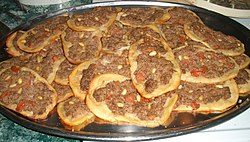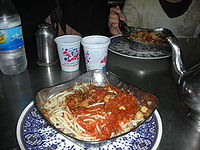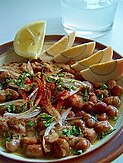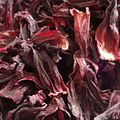This is an old revision of this page, as edited by 41.137.70.108 (talk) at 23:37, 21 July 2015 (→Northwest Africa). The present address (URL) is a permanent link to this revision, which may differ significantly from the current revision.
Revision as of 23:37, 21 July 2015 by 41.137.70.108 (talk) (→Northwest Africa)(diff) ← Previous revision | Latest revision (diff) | Newer revision → (diff)| This article needs additional citations for verification. Please help improve this article by adding citations to reliable sources. Unsourced material may be challenged and removed. Find sources: "Arab cuisine" – news · newspapers · books · scholar · JSTOR (April 2013) (Learn how and when to remove this message) |

Arab cuisine (Template:Lang-ar) is defined as the various regional cuisines spanning the Arab world, from Mesopotamia to North-Africa. Arab cuisine often incorporates the Levantine and Egyptian culinary traditions.
Diet and foods
Originally, the Arabs of the Arabian Peninsula relied heavily on a diet of dates, wheat, barley, rice, and meat, with little variety and heavy emphasis on yogurt products, such as labneh (لبنة) (yogurt without butterfat).
There is a strong emphasis on the following items in Arab cuisine:
- Meat: lamb and chicken are the most used, with beef, goat, and camel used to a lesser extent. Other poultry is used in some regions, and fish is used in coastal areas. Pork is completely prohibited for Muslim Arabs, being both a cultural and religious taboo (Haram) and prohibited under Islamic law, whereas many Christian Arabs do eat and enjoy pork products, especially in Lebanon, where cold cuts of ham are frequently consumed in Christian neighbourhoods.
- Dairy products: dairy products are widely used, especially yogurt and white cheese. Butter and cream are also used extensively.
- Herbs and spices: mint and thyme (often in a mix called za'atar) are widely and almost universally used; spices are used much less than in Indian cuisine, but the amount and types generally varies from region to region. Some of the included herbs and spices are sesame, saffron, turmeric, garlic, cumin, cinnamon, and sumac. Spice mixtures include baharat.
- Beverages: hot beverages are served more than cold, coffee being on the top of the list, mostly in the Arab States of the Persian Gulf. However, tea is also served in many Arab countries. In Egypt and Jordan, for instance, tea is a more important hot beverage than coffee.
- Grains: rice is the staple and is used for most dishes; wheat is the main source for bread. Bulgur and semolina are also used extensively.
- Legumes: lentils are widely used, as well as fava beans and chickpeas (garbanzo beans).
- Fruits and vegetables: Arab cuisine also favors vegetables such as cucumbers, eggplant (aubergine), zucchini (courgette), okra, onions, and fruits (primarily citrus), which are often used as seasonings for entrees. Olives, as well as dates, figs, and pomegranates are also widely used. Dates are a particularly important staple in the Arab diet, often eaten with coffee.
- Nuts: almonds, peanuts, pine nuts, pistachios, and walnuts are often included.
- Greens: parsley and mint are popular as seasonings in many dishes, while spinach and mulukhiyah (leaves from the plant of the Corchorus genus) are used in cooked dishes.
- Dressings and sauces: the most popular dressings include various combinations of olive oil, lemon juice, parsley or garlic, as well as tahini (sesame paste). Labaneh (thinned yogurt) is often seasoned with mint, onion, or garlic, and served as a sauce with various dishes.
Notably, many of the same spices used in Arab cuisine are also those emphasized in Indian cuisine. This is a result of heavy trading and historical ties between the two regions, and also because many South Asian expats live in the Arab States of the Persian Gulf.
Culture
Essential to any cooking in the Arabian Peninsula is the concept of hospitality and generosity. Meals are generally large family affairs, with much sharing and a great deal of warmth over the dinner table. Formal dinners and celebrations generally involve large quantities of lamb, and every occasion entails large quantities of Arabic coffee. In an average Arab state household, a visitor might expect a dinner consisting of a very large platter, shared commonly, with a vast amount of rice, incorporating lamb or chicken, or both, as separate dishes, with various stewed vegetables, heavily spiced, sometimes with a tomato-based sauce. Most likely there would be several other less hearty items on the side. Tea would certainly accompany the meal, as it is almost constantly consumed. Coffee would be included in the same manner.
There are many regional differences in Arab cuisine. For instance, mujadara in Syria and Lebanon is different from mujadara in Jordan and Palestine. Some dishes, such as mansaf (the national dish of Jordan), are native to certain countries and rarely, if ever, make an appearance in other countries. Unlike in most Western cuisines, cinnamon is used in meat dishes, as well as in sweets such as baklava. Other desserts include variations of rice pudding and fried dough. Groundnuts are a common filling for such treats. Saffron is used in everything, including sweets, rice, and beverages. Fruit juice is quite popular due to the climate. Due to historical interactions, Arab cuisine has been imminently influenced by Persian and Turkish culture. The rice dish known as pilaf is very popular in Arab countries and among Arab communities around the world.
Structure of meals
There are two basic structures for meals in the Arab World, one regular and one specific for the month of Ramadan.
Breakfast
Cafés often serve croissants for breakfast. Breakfast is often a quick meal, consisting of bread and dairy products, with tea and sometimes jam. The most used is labneh and cream (kishta, made of cow's milk; or qaimar, made of domestic buffalo milk). Labneh is served with olives, dried mint, and drizzled with olive oil. Pastries such as manaqeesh, sfiha, fatayer, and kahi are sometimes eaten for breakfast. Flat bread with olive oil and za'atar is also popular. Most Arab families also consume hummus and falafel with pita bread.
Traditionally, breakfast used to be a much heavier meal, especially for the working class, and included dishes such as lentil soup (shorbat 'adas), or heavy sweets such as knafa. Ful, which is fava beans cooked with chickpeas (garbanzo beans), garlic, lemon, and olive oil, is a popular working class breakfast in the Levant and Egypt. Lablabi is another heavy garbanzo-based stew popular for breakfast in Tunisia.
Lunch
Lunch is considered the main meal of the day, and is traditionally eaten between 1:30pm and 2:30pm. It is the meal for which the family comes together, and when entertaining, it is the meal of choice to invite guests to. Rarely do meals have different courses; however, salads and mezze (an appetizer) are served as side dishes to the main meal. The latter usually consists of a portion of meat, poultry or fish, a portion of rice, lentils, bread or bagel, and a portion of cooked vegetables, in addition to the fresh ones with the mezze and salad. The vegetables and meat are usually cooked together in a sauce (often tomato, although others are also popular) to make maraq, which is served on rice. Most households add bread, whether other grains were available or not. Drinks are not necessarily served with the food; however, there is a very wide variety of drinks such as shineena (or laban), karakaden, Naqe'e Al Zabib, irq soos, tamr Hindi, and fruit juice, as well as other traditional Arab drinks. During the 20th century, carbonated soda and fruit-based drinks, sold by supermarkets, have also become very popular.
Dinner
Dinner is traditionally the lightest meal, although in modern times, and due to changing lifestyles, dinner has become more important.
Desserts and Ramadan meals
In addition to the two meals mentioned hereafter, sweets are consumed much more than usual during the month of Ramadan; sweets and fresh fruits are served between these two meals. Although most sweets are made all year round such as knafeh, baklava, and basbousa, some are made especially for Ramadan, such as qatayef.
Iftar
Iftar (also called Futuur, or Afur in the Somali language), or fast-breaking, is the meal taken at dusk when the fast is over. The meal consists of three courses: first, they shall eat a date based on Islamic tradition. This is followed by a soup or anything they would like, the most popular being lentil soup, but a wide variety of soups such as chicken, oats, freeka (a soup made from whole wheat and chicken broth), potato, maash, and others are also offered. The third course is the main dish, usually eaten after an interval, when Maghreb prayer is conducted. The main dish is mostly similar to lunch, except that cold drinks are also served.
Sahur
Sahur is the meal eaten just before dawn, when fasting must begin. It is eaten to help the person make it through the day with enough energy until Maghreb time.
Regional Arab cuisines
Eastern Arabia
Main article: Arab cuisine of the Persian GulfThe cuisine of Eastern Arabia today is the result of a combination of richly diverse cuisines, incorporating Persian, Levantine, Yemeni, and Indian cuisine, as well as many items not indigenous to the Persian Gulf region, which were imported in dhows and caravans. Do not forget that harees, fattah, and many other dishes are originally from the Persian Gulf.
Yemen
Main article: Yemeni cuisineThe cuisine of Yemen is rather distinct from other Arab cuisines. Like most other Arab cuisines, chicken, goat, and lamb are eaten more often than beef. Fish is eaten mostly in coastal areas. However, unlike most Arab countries, cheese, butter, and other dairy products are less common, especially in the cities and other urban areas. As with other Arab cuisines, the most widespread beverages are tea and coffee; tea is usually flavored with cardamom, clove, or mint, and coffee with cardamom. Karakaden, Naqe'e Al Zabib, and diba’a are the most widespread cold beverages.
Although each region has their own variation, Saltah (سلتة) is considered the national dish of Yemen. The base is a brown meat stew believed to be of Turkish origin called maraq (مرق), a dollop of fenugreek froth, and sahawiq (سحاوق) or sahowqa (a mixture of chili peppers, tomatoes, garlic, and herbs ground into a salsa). Rice, potatoes, scrambled eggs, and vegetables are common additions to saltah. It is eaten with flat bread, which serves as a utensil to scoop up the food. Other dishes widely known in Yemen include: aseed, fahsa, thareed, Samak Mofa, mandi, fattah, shakshouka, shafut, Bint Al-Sahn, kabsa, and jachnun.
The Levant

Levantine cuisine is the traditional cuisine of the Levant, Mashriq, or Greater Syria area. Although now divided into Syria, Lebanon, Jordan, Iraq, Palestine and Israel, the region has historically been more united, and shares most of the same culinary traditions. Although almost identical, there is some regional variation within the Levantine area.
In general, Levantine foods have much in common with other eastern Mediterranean cuisines, such as Greek and Turkish cuisine, as well as Armenian cuisine.
Some of the basic similarities are the extensive use of olive oil, za'atar, and garlic, and common dishes include a wide array of mezze or bread dips, stuffings, and side dishes such as hummus, falafel, ful, tabouleh, labaneh, and baba ghanoush.
It also includes copious amounts of garlic and olive oil, often seasoned with lemon juice—almost no meal goes by without including these ingredients. Most often foods are either grilled, baked, fried, or sautéed in olive oil; butter and cream are rarely used, other than in a few desserts. Vegetables are often eaten raw or pickled, as well as cooked. While the cuisine does not boast a multitude of sauces, it focuses on herbs, spices, and the freshness of ingredients.

Iraqi cuisine utilizes more spices than most Arab cuisines. Iraq's main food crops include wheat, barley, rice, vegetables, and dates. Vegetables include eggplant, okra, potatoes, and tomatoes. Pulses such as chickpeas and lentils are also quite common. Common meats in Iraqi cooking are lamb and beef; fish and poultry are also used.
Soups and stews are often prepared and served with rice and vegetables. Mansaf is a popular dish. Biryani, although influenced by Indian cuisine, is milder with a different mixture of spices, and a wider variety of vegetables, including potatoes, peas, carrots, and onions. Dolma is also one of the most popular dishes.
The Iraqi cuisine is famous for its extremely tender kebab, as well as its tikka. A wide variety of spices, pickles, and amba are also extensively used.
In the West Bank, the Gaza Strip, and Jordan, the population has a cooking style of their own, involved in roasting various meats, baking flat breads, and cooking thick yogurt-like pastes from goat's milk.
Musakhan is a common main dish, famous in northern Jordan, the city of Jerusalem, and northern West Bank. The main component is taboon bread, which is topped with pieces of cooked sweet onions, sumac, saffron, and allspice. For large dinners, it can be topped by one or two roasted chickens on a single large taboon bread.
The primary cheese of the Palestinian mezze is Ackawi cheese, which is a semi-hard cheese with a mild, salty taste and sparsely filled with roasted sesame seeds.
Maqluba is another popular meal in Jordan and central Palestine. Mujaddara, another food of the West Bank, as well as in the Levant in general, consists of cooked green lentils, with bulghur sauteed in olive oil. Mansaf is a traditional meal, and the national dish of Jordan, having roots in the Bedouin population of the country. It is mostly cooked on special occasions such as Ramadan, Eid ul-Fitr, a birth, or a large dinner gathering. Mansaf is a leg of lamb or large pieces of mutton, on top of a markook bread that has been topped with yellow rice. A type of thick dried yogurt made from goat's milk, called jameed, is poured on top of the lamb and rice to give it its distinct flavor and taste. The dish is garnished with cooked pine nuts and almonds.
Levantine cuisine is also famous for its wide range of cheeses like Shanklish, Halloum, and Arisheh. Kishk is also a famous Syrian soup, alongside many soups made of lentils. Lebanese food also has a wide range of dips like Hummous, Baba Ghannouj, and Labneh, and also caters many raw meat dishes. Syrian food could be either extremely vegetarian or a meat lover's paradise. Lemon, oregano, za'atar, paprika, and various other Mediterranean spices and herbs are used in Syrian cuisine.
To top it off, Syrian cuisine also incorporates wine made in Syria and the Syrian equivalent of the Greek Ouzo, known as Arak. Syrians have invented their own dishes over the centuries, some of the most popular being raw Kebbeh, grilled Kebbeh, meat Sfiha, and Arak.
Egypt
Main article: Egyptian cuisine| This section needs expansion. You can help by adding to it. (June 2008) |

Egyptian cuisine is a very rich cuisine that has many unique customs. These customs may also vary within Egypt itself, for example, in the coastal areas, like the coast of the Mediterranean Sea and Canal, the diet of the people relies heavily on fish. In the more agricultural areas, the reliance on farm products is much heavier. Duck, geese, chicken, and river fish are the main animal protein sources. Unlike the surrounding Arab cuisines, which place heavy emphasis on meat, Egyptian cuisine is rich in vegetarian dishes; three national dishes of Egypt; ful medames, ta'amia (also known in other countries as falafel), and kushari, are generally vegetarian. Fruits are also greatly appreciated in Egypt: mangoes, grapes, bananas, apples, sycamore, guavas, and peaches are very popular, especially because they are all domestically produced and are available in relatively low prices. Another famous dessert from Egypt is called Om or Um Ali, which is similar to a bread and butter pudding made traditionally with puff pastry, milk, and nuts. It is served all across the Middle East and is also made on special occasions such as Eid.
Somalia

Somali cuisine varies from region to region, and consists of an exotic mixture of native Somali, Ethiopian, Yemeni, Persian, Turkish, Indian, and Italian culinary influences. It is the product of Somalia's rich tradition of trade and commerce.
Among the favorite Somali dishes include xalwo (halva), a sweet hardened jelly; soor, a soft cornmeal mashed with fresh milk, butter, and sugar, and served with maraq (stew); and sambuusa, a small fried pastry with a filling of meat and vegetables.
Sudan
Main article: Sudanese cuisineIn comparison to its North African and Levantine neighbors, the cuisine of Sudan tends to be generous with spices. The Sudanese cuisine has a rich variety in ingredients and creativity. Simple everyday vegetables are used to create stews and omelettes that are healthy yet nutritious, and full of energy and flair. These stews are called mullah. One could have a zucchini mullah, spinach "Riglah" mullah, etc. Sudanese food inspired the origins of Egyptian cuisine and Ethiopian cuisine, both of which are very popular in the Western world. Popular dishes include Ful medames, Shahan ful, Hummus, Bamya (a stew made from ground, sun dried okra), and Gurasa (pancake), as well as different types of salads and sweets.
-
 Shahan ful presented alongside olive oil, berbere, various vegetables, and a roll of bread
Shahan ful presented alongside olive oil, berbere, various vegetables, and a roll of bread
Dishes
| Name | Image | Description |
|---|---|---|
| Basbousa بسبوسة | 
|
|
| Couscous كُسكُسي | 
|
|
| Dolma ضولمة | 
|
|
| Ful Medames فول مدمس | 
|
An Egyptian dish of cooked and mashed fava beans served with vegetable oil, cumin, and optionally with chopped parsley, onion, garlic, lemon juice, and chili pepper. |
| Kleeja كليجا | 
|
|
| Maqluba مقلوبه | 
|
|
| Mutabbaq مطبق | 
|
A stuffed pancake or pan-fried bread, which is commonly found in Saudi Arabia (especially the Tihamah and the Hejaz regions), Yemen, India, Indonesia, Malaysia, Singapore, Brunei and Thailand. |
| Pickled lemon ليمون مخلل | 
|
|
| Shish kebab كباب | 
|
-
 Lahm Ba'ajeen لحم بعجين
Lahm Ba'ajeen لحم بعجين
-
 Manakish مناقيش
Manakish مناقيش
-
 Kabsa كبسة
Kabsa كبسة
-
Kebbeh كبة-كبيبة
-
 Ma'amoul معمول
Ma'amoul معمول
-
 Matboha مطبوخة
Matboha مطبوخة
-
 Baba Ghanoush بابا غانوج
Baba Ghanoush بابا غانوج
-
 Hummus حمصية
Hummus حمصية
-
 Waraq Enab ورق عنب - ملفوف
Waraq Enab ورق عنب - ملفوف
-
 Labneh لبنة
Labneh لبنة
-
 Kanafeh كنافة
Kanafeh كنافة
-
 Ka'ak كعك - كحك
Ka'ak كعك - كحك
-
Baklava بقلاوه
-
 Coffee قهوة
Coffee قهوة
-
 Hibiscus tea كركديه - عنآب
Hibiscus tea كركديه - عنآب
-
 Luqmat al-qadi لفمة الفاضي
Luqmat al-qadi لفمة الفاضي
-
 Halva حلاوة
Halva حلاوة
- Qatayef القطائف Qatayef القطائف
-
 Shish taouk شيش طاوك
Shish taouk شيش طاوك
-
 Toum تومية
Toum تومية
-
Fattoush فتوش
-
 Sambusak سمبوسك
Sambusak سمبوسك
-
Falafel فلافل - طعمية
-
 Kleicha الكليجة - كعب الغزال
Kleicha الكليجة - كعب الغزال
Pastries
| This section is empty. You can help by adding to it. (July 2015) |
See also
- Halal
- Haram
- Jordanian cuisine
- Lebanese cuisine
- List of African dishes
- Muslim dietary laws
- Palestinian cuisine
References
- Nabeel Y. Abraham. "Arab Americans," Encarta Encyclopedia 2007. Archived 2009-10-31.
- Gulf Recipes and Cuisine - Page 1 - Shahiya.com
- "Umm Ali Recipe - Egyptian Bread Pudding".
External links
 Media related to Arabic cuisine at Wikimedia Commons
Media related to Arabic cuisine at Wikimedia Commons
| Asian cuisine | |
|---|---|
| Sovereign states |
|
| States with limited recognition | |
| Dependencies and other territories | |
| African cuisine | |
|---|---|
| Sovereign states |
|
| States with limited recognition | |
| Dependencies and other territories |
|
| Middle Eastern cuisine | |
|---|---|
| Mediterranean cuisine | |||||||||||||||||||||||||||||
|---|---|---|---|---|---|---|---|---|---|---|---|---|---|---|---|---|---|---|---|---|---|---|---|---|---|---|---|---|---|
| Regions |
| ||||||||||||||||||||||||||||
| Staples | |||||||||||||||||||||||||||||
| Shared | |||||||||||||||||||||||||||||
| Exemplars | |||||||||||||||||||||||||||||
| Lists of prepared foods | |||||||||||||||||||||
|---|---|---|---|---|---|---|---|---|---|---|---|---|---|---|---|---|---|---|---|---|---|
| Dishes by origin |
| ||||||||||||||||||||
| By type and origin |
| ||||||||||||||||||||
| By type |
| ||||||||||||||||||||